Inductive interaction/coupling between inductors is many times underrated/ignored and some times just tested on how the inductance changes between coils which is just one part of the real problem.
I was researching about crossover inductors position practices myths and facts(see here) on how audible and at what power levels this really became a problem but I was unable to find any A/B blind tests on the net.
Then to make the long story short(sorta), I was completely chocked on my own findings, I was able to drive a compression driver connected to an 0.7mH 20AWG inductor by exiting an 1.5mH 14AWG inductor and placing them just few inches in the lay-down position, the closer they become the louder the compression driver becomes, and in the recommended position I fount that putting the outer windings out of phase is the least affected position.
My tests was very simple and no expensive measurement gear was required.
Used parts list if some what to reproduce the tests(parts don't have to be exact):
1) An 1.5mH 14AWG inductor.
2) An 0.7mH 20AWG inductor.
3) An 33uF MKP capacitor.
4) An non-inductive 20W resistor.
I've used a piezo compression driver for the test as those things are sensitive but I believe any sensitive 8-ohms CD can be used as well, also I've used a standard Class A/B amplifier and put some load(fast electronic music) into an 12W 5-ohms resistor until the 1.5mH inductor made some electro-magnetic field to make an screw driver vibrate inside the hole then I've stopped increasing the volume, at this point the 12W 5-ohms resistor is hot to the touch but not burning, to my surprise I was able to even hear the kick-drum into the compression driver😱.
To conclude this simple test I believe that even 4 inches of proximity is not enough for lay-down oriented crossover coils, also the most affected are the users of high sensitivity speakers such as compression drivers.
Here is the simple test diagram:
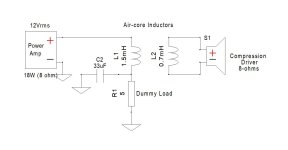
Here is the recommended inductor position with coil outer windings out of phase:
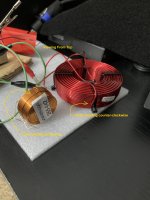
Here is the modified crossovers from my old bookshelf speaker build, the midrange is way cleaner at high volume and the center image is now wider and immersive:
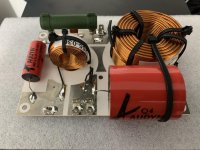
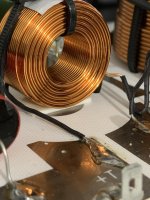
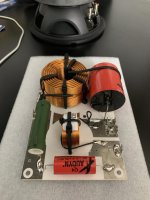
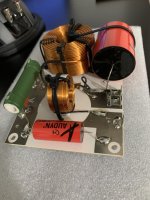
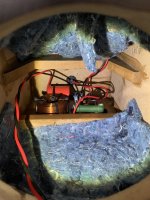
Regards!
I was researching about crossover inductors position practices myths and facts(see here) on how audible and at what power levels this really became a problem but I was unable to find any A/B blind tests on the net.
Then to make the long story short(sorta), I was completely chocked on my own findings, I was able to drive a compression driver connected to an 0.7mH 20AWG inductor by exiting an 1.5mH 14AWG inductor and placing them just few inches in the lay-down position, the closer they become the louder the compression driver becomes, and in the recommended position I fount that putting the outer windings out of phase is the least affected position.
My tests was very simple and no expensive measurement gear was required.
Used parts list if some what to reproduce the tests(parts don't have to be exact):
1) An 1.5mH 14AWG inductor.
2) An 0.7mH 20AWG inductor.
3) An 33uF MKP capacitor.
4) An non-inductive 20W resistor.
I've used a piezo compression driver for the test as those things are sensitive but I believe any sensitive 8-ohms CD can be used as well, also I've used a standard Class A/B amplifier and put some load(fast electronic music) into an 12W 5-ohms resistor until the 1.5mH inductor made some electro-magnetic field to make an screw driver vibrate inside the hole then I've stopped increasing the volume, at this point the 12W 5-ohms resistor is hot to the touch but not burning, to my surprise I was able to even hear the kick-drum into the compression driver😱.
To conclude this simple test I believe that even 4 inches of proximity is not enough for lay-down oriented crossover coils, also the most affected are the users of high sensitivity speakers such as compression drivers.
Here is the simple test diagram:

Here is the recommended inductor position with coil outer windings out of phase:

Here is the modified crossovers from my old bookshelf speaker build, the midrange is way cleaner at high volume and the center image is now wider and immersive:





Regards!
at what power levels this really became a problem
For either of these to be valid, the inductors would have to show this effect not in proportion to the signal applied. However you should be measuring the same at different levels.also the most affected are the users of high sensitivity speakers such as compression drivers.
Hi @AllenB, that's a good point, I just tested with a steady power level then played with inductor proximity only, however I will make some more tests with a regular 8-ohms compression driver with variable power levels to see if the compression driver/tweeter changes in output volume in regards to the power applied to the dummy load.🤔
Regards!
Regards!
Interestingly while I was testing this time on an standard HF10AK/LTH102 connected to the 0.7mH inductor and a 47uF protection capacitor, after increasing the volume I've started to hear like lower midrange coming from the CD, and pushing the volume up slowly increased the compression driver output level.
So I wanted to get a bit more harsh in this test and connected an PRV 10W650A 10" woofer directly to the inductor and I was hearing again low midrange coming out, the higher the amplifier volume louder it became, it just needed a bit more power, unfortunately I was limited to ~40W since didn't found my 200W loads, but seems that the stronger the voltage/current flowing through the bass inductor do increases the near inductors voltage output as well maximizing the cross-talk effect, also the frequency response remained the same in both tests the CD and the woofer just lower midrange alike was heard.
However it seems that this inductor coupling cross-talk is mostly masked at high power levels and almost inaudible at low power levels but easily detected by some apparently, by the way I will start using the recommended crossover inductors position regardless on my passive builds.😉
Maybe the next test can be testing the voltage across the pickup inductor at different amp power levels as well to found a ratio.
Regards!
So I wanted to get a bit more harsh in this test and connected an PRV 10W650A 10" woofer directly to the inductor and I was hearing again low midrange coming out, the higher the amplifier volume louder it became, it just needed a bit more power, unfortunately I was limited to ~40W since didn't found my 200W loads, but seems that the stronger the voltage/current flowing through the bass inductor do increases the near inductors voltage output as well maximizing the cross-talk effect, also the frequency response remained the same in both tests the CD and the woofer just lower midrange alike was heard.
However it seems that this inductor coupling cross-talk is mostly masked at high power levels and almost inaudible at low power levels but easily detected by some apparently, by the way I will start using the recommended crossover inductors position regardless on my passive builds.😉
Maybe the next test can be testing the voltage across the pickup inductor at different amp power levels as well to found a ratio.
Regards!
Nevertheless I found some good reading about the mutual inductance coupling, distances and its varying ratios, the topic is definitely more complex that it seems but we can have an idea in this regards wen designing passive crossovers.🔊
Mutual Inductance
Regards!
Mutual Inductance
Regards!